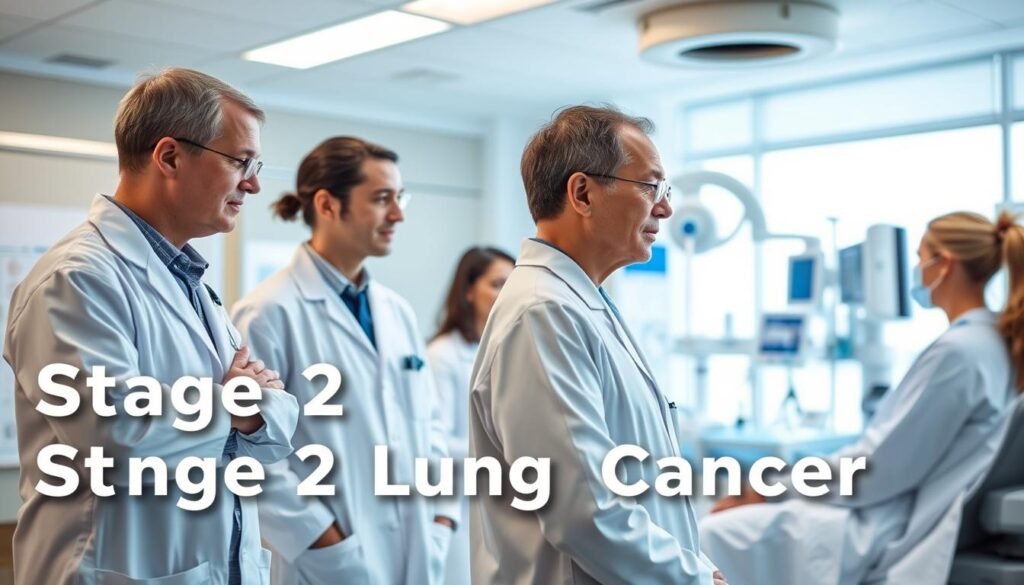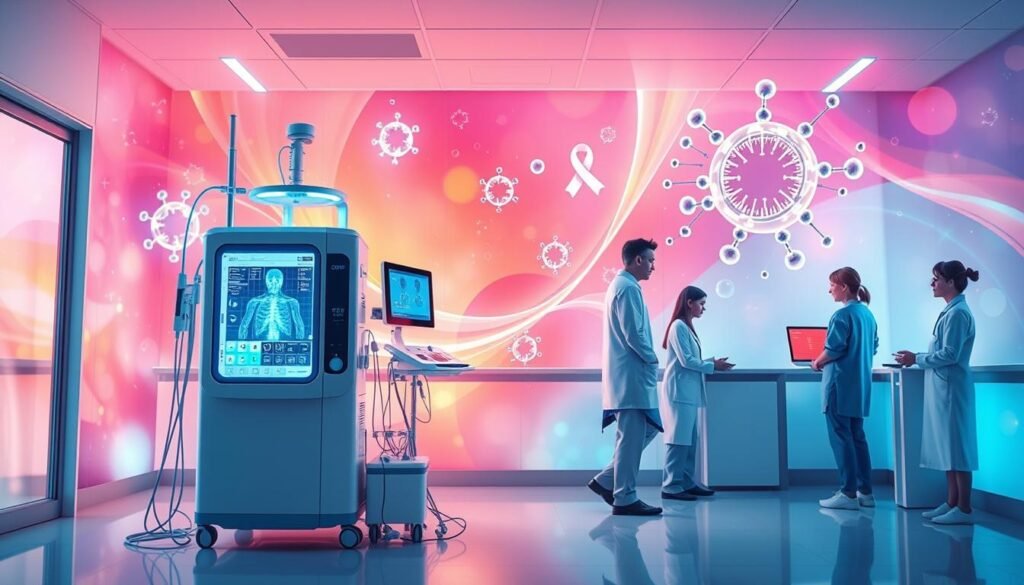The five-year survival rate for stage 2 non-small cell lung cancer (NSCLC) is between 53% and 60%. This number is important for patients and their families. It offers hope and helps them understand what they’re facing. Knowing this rate helps in making choices about treatments and lifestyle changes.
Stage 2 lung cancer is an intermediate stage. The cancer has grown beyond the original tumor but hasn’t reached distant organs. Patients often want to know their survival chances. They look into different treatments. Factors like health, age, and how well treatments work affect their prognosis. It’s important for patients to talk with doctors. They can create a treatment plan that’s right for them.
Key Takeaways
- Stage 2 lung cancer has a five-year survival rate of 53% to 60%.
- Stage 2A has a higher survival rate compared to stage 2B.
- Women generally have a 17% higher survival rate than men with NSCLC.
- Quitting smoking significantly improves prognosis after a lung cancer diagnosis.
- Cancer type and tumor characteristics affect overall survival rates.
- Consulting with healthcare professionals is crucial for tailored treatment options.
- Maintaining a healthy lifestyle can enhance treatment outcomes and overall well-being.
Understanding Stage 2 Lung Cancer
Stage 2 lung cancer is an intermediate stage of cancer. The tumor grows into nearby tissues but hasn’t spread to distant parts of the body. It might affect lymph nodes close by. It’s key to know the lung cancer symptoms early on.
Patients typically face:
- Persistent cough
- Shortness of breath
- Chest pain
- Increased frequency of lung infections
Some people might not show clear signs, making check-ups vital. The chance of living longer with stage 2 lung cancer looks better with proper treatment. The survival rates vary from person to person.
| Stage | 5-Year Survival Rate | Typical Symptoms |
|---|---|---|
| Stage 2A | 50-60% | Persistent cough, shortness of breath |
| Stage 2B | 50-60% | Chest pain, lung infections |
New treatments have greatly improved patient outcomes. A better chance at a longer life highlights the need for knowing lung cancer symptoms. And getting help fast.
What is Non-Small Cell Lung Cancer?
Non-small cell lung cancer, or NSCLC, is the most common lung cancer type. It makes up about 85% of all lung cancer cases. It’s important to understand NSCLC because it includes several subtypes. Each one affects what treatment works best and how well patients might do.
The main types of lung cancer in NSCLC are:
- Lung adenocarcinoma – This type usually appears in the lungs’ outer areas. It’s the most frequent kind among nonsmokers.
- Squamous cell carcinoma – Often related to smoking, it starts in the central parts of the lungs.
- Large cell carcinoma – This kind grows quickly and can spread to other body parts.
Each subtype of NSCLC is unique. They differ in how aggressive they are and how they respond to treatments. Knowing these details helps doctors create the best care plans. It also helps predict how well patients will recover.
Classification of Stage 2 Lung Cancer
Stage 2 lung cancer is split into two types: stage 2A and stage 2B. Knowing the difference is key for choosing the right treatment. Stage 2A involves tumors that are 4 to 5 centimeters. They haven’t spread to nearby lymph nodes but might have grown into nearby areas.
Stage 2B lung cancer is a bit different. It can have smaller tumors that have spread to lymph nodes or larger tumors up to 7 centimeters, without affecting the nodes. How big the tumor is and if it has spread are important in deciding on treatment.
The TNM classification system is crucial for understanding these stages. It looks at tumor size, lymph node involvement, and if the cancer has spread far away. Using the TNM system helps doctors figure out the best treatment for each patient.
| Stage | Tumor Size | Lymph Node Involvement |
|---|---|---|
| Stage 2A | 4-5 cm | No |
| Stage 2B | 3-5 cm or 5-7 cm | Yes or No |
Using the terms stage 2A and stage 2B helps pick the best treatments. The TNM system’s role in treating lung cancer is very important.
Survival Rate for Stage 2 Lung Cancer
Knowing the survival rate for stage 2 lung cancer is vital. It helps patients and their families understand what to expect. It shows how well treatments work and what happens when the disease is caught early. Many studies show different results, highlighting survival differences due to health and stage.
Five-Year Survival Statistics
The five-year survival statistics share important facts. About 40 to 55% of people with stage 2 lung cancer live for at least five years. When we look closer at stage 2A, the survival rate is between 60% and 75%. However, stage 2B’s survival rate drops to about 40% to 55%. The National Cancer Institute gives a general rate of 35%, showing how varied survival can be.
Comparison Between Stage 2A and 2B
Comparing stage 2A and 2B lung cancer shows big differences. Those with stage 2A have a better chance, likely because their tumors are less aggressive. They also get timely treatment. People with stage 2B have a tougher time, with lower survival rates. This fact highlights why it’s crucial to have treatments that fit each person and to act fast when there are early symptoms. For help identifying early lung cancer signs, visit this resource.

Factors Affecting Lung Cancer Survival Rates
Understanding lung cancer survival rates is key for patients and their doctors. Every patient’s case is unique, affected by many factors. These can change their chances of recovery.
Treatment Response
Treatment effectiveness is critical for stage 2 lung cancer survival. Surgery, chemo, and radiation work differently for each person. Many lung cancer patients seek treatment, hoping to get better.
Overall Health and Age
Your overall health and age play big roles in your survival chances. Younger patients usually do better than older ones. After 60, especially for women, survival rates can improve. Other health issues can also affect how well you respond to treatment.
Tumor Characteristics
The size, place, and if the lymph nodes are involved matter a lot. Each lung cancer type affects survival differently. Poorly differentiated tumors usually mean higher risk. Those with squamous cell carcinoma have tougher odds. Understanding these points helps doctors plan the best treatment.
Treatment Options for Stage 2 Lung Cancer
Stage 2 lung cancer treatment varies and is personalized for each patient. These treatments can increase survival and better life quality. They mix surgery and other methods.
Surgical Interventions
Surgery is key for stage 2 non-small cell lung cancer. A lobectomy removes a lung lobe to try for a total cure. Other surgeries like segmentectomy or pneumonectomy are options, based on tumor size and place. Surgery’s success greatly influences the results of stage 2 lung cancer treatments.
Radiation Therapy
For those who can’t have surgery, radiation therapy is an option. It uses high-energy rays to kill cancer cells. Studies suggest radiation after surgery doesn’t always improve survival. So, it’s crucial to assess carefully for the best results.
Chemotherapy and Immunotherapy
Chemotherapy is often paired with surgery for stage 2 lung cancer. It aims to destroy any lingering cancer cells. Drugs like cisplatin and vinorelbine help increase survival for some. Plus, Atezolizumab (Tecentriq) serves patients who’ve had surgery and chemotherapy without their disease getting worse. These treatments are advancing lung cancer care, offering hope to those facing stage 2 lung cancer.
| Treatment Option | Description | Purpose |
|---|---|---|
| Surgery | Surgical removal of the tumor. | Best chance for complete cancer removal. |
| Radiation Therapy | High-energy rays to kill cancer cells. | Target remaining cancer cells post-surgery or for inoperable cases. |
| Chemotherapy | Drugs like cisplatin and vinorelbine. | Eliminate remaining cancer cells post-surgery. |
| Immunotherapy | Atezolizumab for suitable candidates. | Focus on enhancing the immune response against cancer. |
Lung Cancer Screening and Early Detection
Early detection of lung cancer is crucial for improving survival rates. Screening is key, especially for those at high risk like long-term smokers or those with family history. Low-dose CT scans are effective at spotting early signs of lung cancer.
Screening’s benefits are evident. Studies show that early-detected lung cancer can have a 20-year survival rate of up to 81%. Sadly, less than 6% of those eligible get screened. This results in lost chances for early treatment.
The International Early Lung Cancer Action Program (I-ELCAP) stresses early CT screening’s value. Early-stage diagnosed patients have a 10-year survival rate of 81%. Those with stage I lung cancer smaller than 10mm have a 95% survival rate over ten years.
Research also finds low-dose CT scans better than chest X-rays at finding non-calcified nodules. They spotted such nodules in 23% of patients, compared to 7% with X-rays. CT scans also detected cancer more effectively, at 2.7% versus 0.7%.
To sum up, lung cancer screenings are highly beneficial. They not only allow for successful treatment but also improve survival outlooks significantly. It’s crucial for high-risk individuals to participate in screening programs. This can save lives and increase long-term survival rates.
Clinical Trials for Stage 2 Lung Cancer
Clinical trials are key to finding new treatments for stage 2 lung cancer. They test new therapies and aim to improve current treatments. This can lead to better results for patients. People in these trials can try new drugs or treatments not yet out in the public.
Taking part in clinical trials can advance medical knowledge. If you’re thinking about joining one, talk with your healthcare provider. This talk can help you understand the pros and cons. It will help you make a smart choice about participating.
Clinical trials cover different treatment areas, including:
- Testing new drug combinations
- Evaluating targeted therapies for specific gene mutations
- Studying immunotherapy’s effectiveness
- Assessing the use of personalized treatment plans developed by multidisciplinary teams
Joining a clinical trial can have a big impact. It benefits not just the participant but future patients too. For more info, look at trustworthy sites and articles. One example is clinical guidelines and research articles.

Clinical trials offer a chance to be part of the latest research. Discussing these options is important. It could lead to better treatments for patients.
| Trial Focus | Description |
|---|---|
| New Drug Combinations | Investigating the efficacy of combining various medications to enhance effectiveness. |
| Targeted Therapies | Searching for treatments aimed at specific genetic mutations in tumors. |
| Immunotherapy Studies | Assessing how the immune system can be better utilized against lung cancer. |
| Multidisciplinary Approaches | Creating tailored treatment plans involving experts from various specialties. |
Support Resources for Lung Cancer Patients
Support is key for anyone fighting lung cancer. They provide much-needed help during tough times. Emotional support can come from different places and services, helping patients through their journey with resilience and hope. It’s important to check out all the resources that can really make a difference in how patients feel emotionally and mentally.
Emotional and Psychological Support
There are many groups out there offering support for lung cancer patients, like counseling, patient groups, and community networks. Being with people who understand what you’re going through can help fight off loneliness. This creates a space filled with understanding and empathy, making it easier to handle what’s happening.
CancerCare has a special helpline for lung cancer. It connects patients with expert social workers to find the right emotional support and resources. Support groups and workshops let patients share and learn from each other’s stories.
Having the right information is crucial for a patient’s journey. Workshops offer a chance to ask experts questions and better understand their illness and treatment options.
In the end, having emotional support can make patients stronger during treatment. By using these resources, patients can find the strength and courage to face their cancer journey head-on.
Advances in Treatment for Stage 2 Lung Cancer
In recent years, we’ve seen big advances in treatment for stage 2 lung cancer. Now, there are newer treatments like targeted therapies and immunotherapies. These have gotten better at controlling cancer growth. Doctors find that giving chemotherapy before surgery helps a lot. It can make outcomes better for patients. A common chemo mix is cisplatin and vinorelbine. This mix may help patients live longer.
Atezolizumab (Tecentriq), a type of PD-L1 checkpoint inhibitor, is a new hope. It’s useful for patients with stage 2 non-small cell lung cancer after surgery. If the cancer hasn’t spread post-chemo, this therapy can be great. Scientists are always looking at combining different therapies. They want to find the best ways to help patients.

Treatments for lung cancer are becoming more personalized. They depend on the patient’s genetic makeup and specific cancer traits. Understanding different tumor types, like squamous-cell carcinoma and adenocarcinoma, is key. This knowledge helps in creating treatments just for them. Continued research is crucial. It will improve survival rates and life quality for those affected by lung cancer.
| Treatment Type | Description | Current Status |
|---|---|---|
| Chemotherapy | Cisplatin and vinorelbine combination | Standard treatment option |
| Immunotherapy | Pd-L1 checkpoint inhibitors like Atezolizumab | Promising for post-surgery patients |
| Targeted Therapy | Therapies based on genetic mutations | In research phase |
Conclusion
Understanding stage 2 lung cancer prognosis is complex. It looks at health, treatment options, and cancer traits. The success of treatments, how patients react, and lifestyle habits like smoking affect survival rates. Over time, survival rates for people with non-small cell lung cancer (NSCLC) have gotten better. This is thanks to medical research and new treatments.
Talking with healthcare teams is key for those with stage 2 NSCLC. These talks provide valuable information. They help patients understand their treatment options better. This leads to improved management of lung cancer, enhancing life quality.
Research on lung cancer is making progress. This gives hope that survival rates will keep improving. It’s important for those affected to stay hopeful and active in seeking help. Support systems are vital in the healing and recovery process.